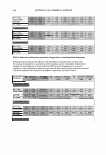ADHESION FAILURE IN HAIR 357 Figure 6. Scale lifting and buckling from extension (S. Ruetsch, private communication). SEM by S. Ruetsch, TRI Princeton. Failure of adhesion between overlapping scales in the cuticle is thought to occur at the hydrophobic outer beta layer, between the outer beta layer and the delta layer as first described by Negri et al. (7). Failure at this site occurs because of the weak hydrophobic bonding between branched hydrocarbons (18-MEA) and relatively short hydrocarbon amino-acid side chains of the hydrophobic fibrous protein layer (d), as depicted in the monolayer model of Figure 2A. This site is conducive to failure when the cuticle layers are strained at low moisture levels and allows the flow of cuticle past cuticle during fiber extension (2,12,14), during extension cycling (13), or even during bending (13,15), particularly in the dry state at relative humidities of 65% or lower. The lower the RH (the moisture content of the hair) the lower the strain at which failure of the scale structure can be initiated between the outer beta layer and the delta layer (13). If the bilayer model (Figure 3) exists, then this type of scale lifting failure would occur between the two fatty-acid bilayers, i.e., between the 18-MEA layer and the fatty acid layer of Figure 3, producing beta-beta failure. This type of failure is not consistent with the conclusions of Negri et al. (7), providing support for the monolayer model over the bilayer model. The different layers of the hair structure are interconnected and stretch dependently. In the dry state, failure often occurs in or between hydrophobic layers because hydrophilic layers are not as extensible at lower moisture levels and therefore force higher strains in the hydrophobic layers for any given stress. FIBER FRACTURE AT LOW RH Extension to break, at lower RH (primarily lower than 30-45% RH), of chemically
358 JOURNAL OF COSMETIC SCIENCE Figure 7. Beta-delta failure from extension of hair fibers in the dry state (21). Reprinted with permission of the Journal of Cosmetic Science. unaltered hair generally provides step fractures rather than smooth fractures. Under this condition, crack initiation is often in the cortex and is initiated at lower strain levels than in the wet state. Therefore, crack propagation occurs at a slower rate. Flaws such as the presence of the medulla (more frequent in thicker fibers) and the intercellular cement can play a role in directing crack propagation in the axial direction to provide step fractures (12). At very low humidity, smooth radial fractures are also observed, with crack initiation in the cortex and brittle failure along the fiber cross section (Figure 4B). CUTICLE CHIPPING VIA EDGE FAILURE IN THE DRY STATE Chipping away of the cuticle edges is a common occurrence in everyday grooming actions (Figure 8). In the d ry state, edge failure most likely begins as outer beta-delta failure, between 18-MEA and the delta layer in the monolayer model (as described), because of weak hydrophobic bonding (Figure 2A), followed by scale edge lifting (Figure 7). Shearing off of scale fragments then results from rubbing actions, as occurs in combing, brushing, or even shampooing. WET-STATE OR HIGH-HUMIDITY FAILURE Deformation in the wet state first leads to deep transverse cracks across the cuticle, and then with continued deformation fiber breakage occurs.
Purchased for the exclusive use of nofirst nolast (unknown) From: SCC Media Library & Resource Center (library.scconline.org)






































































































